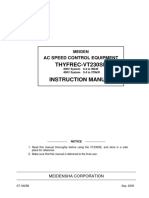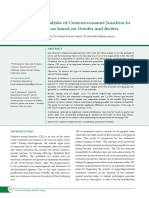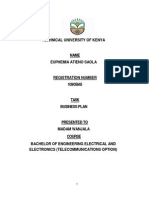Structures of Teeth 4
Structures of Teeth 4
Uploaded by
Tayyuba AslamCopyright:
Available Formats
Structures of Teeth 4
Structures of Teeth 4
Uploaded by
Tayyuba AslamCopyright
Available Formats
Share this document
Did you find this document useful?
Is this content inappropriate?
Copyright:
Available Formats
Structures of Teeth 4
Structures of Teeth 4
Uploaded by
Tayyuba AslamCopyright:
Available Formats
Chapter 1—Clinical Significance of Dental Anatomy, Histology, Physiology, and Occlusion 5
Enamel E
Lamella
Dentinoenamel
junction
Dentinal part
of lamella
Dentin
D
Fig. 1-9 Microscopic view through lamella that goes from enamel
surface into dentin. Note the enamel tufts (arrow). (From Bath Balogh M,
Fehrenbach MJ: Illustrated dental embryology, histology, and anatomy, ed 3,
Fig. 1-10 Microscopic view of scalloped dentinoenamel junction (DEJ)
Saunders, 2011, St Louis. Courtesy James McIntosh, PhD, Assistant Professor Emeri-
(arrow). E, enamel; D, dentin. (From Bath Balogh M, Fehrenbach MJ: Illustrated
tus, Department of Biomedical Sciences, Baylor College of Dentistry, Dallas, TX.)
dental embryology, histology, and anatomy, ed 3, Saunders, 2011, St Louis.
Courtesy James McIntosh, PhD, Assistant Professor Emeritus, Department of Bio-
medical Sciences, Baylor College of Dentistry, Dallas, TX.)
between enamel rod groups that extend from the enamel
surface toward the DEJ, sometimes extending into dentin (see
Fig. 1-9). They contain mostly organic material, which is a
weak area predisposing a tooth to the entry of bacteria and
dental caries. Enamel rods are formed linearly by successive
apposition of enamel in discrete increments. The resulting
variations in structure and mineralization are called incremen- e
tal striae of Retzius and can be considered growth rings (see f
Fig. 1-3). In horizontal sections of a tooth, the striae of Retzius c
appear as concentric circles. In vertical sections, the lines tra-
verse the cuspal and incisal areas in a symmetric arc pattern, d
descending obliquely to the cervical region and terminating at
the DEJ. When these circles are incomplete at the enamel
surface, a series of alternating grooves, called imbrication lines
of Pickerill, are formed. The elevations between the grooves are
called perikymata; these are continuous around a tooth and
Fig. 1-11 Fissure (f) at junction of lobes allows accumulation of food
usually lie parallel to the CEJ and each other.
and bacteria predisposing the tooth to dental caries (c). Enamel (e);
A structureless outer layer of enamel about 30 µm thick is dentin (d).
found most commonly toward the cervical area and less often
on cusp tips. No prism outlines are visible, and all of the
apatite crystals are parallel to one another and perpendicular
to the striae of Retzius. This layer, referred to as prismless This arrangement leaves a V-shaped escape path between the
enamel, may be more heavily mineralized. Microscopically, the cusp and its opposing groove for the movement of food during
enamel surface initially has circular depressions indicating chewing. Failure of the enamel of the developmental lobes to
where the enamel rods end. These concavities vary in depth coalesce results in a deep invagination of the enamel surface
and shape, and they may contribute to the adherence of plaque and is termed fissure. Non-coalesced enamel at the deepest
material, with a resultant caries attack, especially in young point of a fossa is termed pit. These fissures and pits act as
individuals. The dimpled surface anatomy of the enamel, food and bacterial traps that predispose the tooth to dental
however, gradually wears smooth with age. caries (Fig. 1-11).
The interface of enamel and dentin (dentinoenamel junc- Once damaged, enamel is incapable of repairing itself
tion, or DEJ) is scalloped or wavy in outline, with the crest of because the ameloblast cell degenerates after the formation of
the waves penetrating toward enamel (Fig. 1-10). The rounded the enamel rod. The final act of the ameloblast is secretion of
projections of enamel fit into the shallow depressions of a membrane covering the end of the enamel rod. This layer is
dentin. This interdigitation may contribute to the firm attach- referred to as Nasmyth’s membrane, or primary enamel cuticle.
ment between dentin and enamel. The DEJ is also a hyper- This membrane covers the newly erupted tooth and is worn
mineralized zone approximately 30 µm thick. away by mastication and cleaning. The membrane is replaced
The occlusal surfaces of premolars and molars have grooves by an organic deposit called the pellicle, which is a precipitate
and fossae that form at the junction of the developmental of salivary proteins. Microorganisms may attach to the pellicle
lobes of enamel. These allow movement of food to the facial to form bacterial plaque, which, if acidogenic in nature, can
and lingual surfaces during mastication. A functional cusp be a potential precursor to dental disease.
that opposes a groove (fossa) occludes on enamel and inclines Although enamel is a hard, dense structure, it is permeable
on each side of the groove and not in the depth of the groove. to certain ions and molecules. The route of passage may be
You might also like
- Bloodbank Project PresentationDocument27 pagesBloodbank Project PresentationSI AbirNo ratings yet
- User FileDocument6 pagesUser FileSateesh AgrahariNo ratings yet
- Vt230se English ManualDocument253 pagesVt230se English ManualQuang Bách100% (4)
- OTC119101 OptiX OSN 9800 Hardware DescriptionDocument268 pagesOTC119101 OptiX OSN 9800 Hardware DescriptionRyankirimiNo ratings yet
- Atlas of Oral Histology by Akramjuaim PDFDocument151 pagesAtlas of Oral Histology by Akramjuaim PDFAna Maria Hernandez Ardila100% (1)
- Esthetic Restorative Materials 1Document1 pageEsthetic Restorative Materials 1Tayyuba AslamNo ratings yet
- Producers Bank of The Philippines Vs CADocument2 pagesProducers Bank of The Philippines Vs CAMac100% (1)
- Ignition ScriptingDocument152 pagesIgnition Scriptingvijikesh Arunagiri0% (1)
- Method Statement-Hot Insulation-Piping PDFDocument15 pagesMethod Statement-Hot Insulation-Piping PDFRampal Rahul Rampal Rahul88% (8)
- Structure and Properties of Enamel and DentinDocument17 pagesStructure and Properties of Enamel and DentinFile SeffinaNo ratings yet
- Odontogenic Cysts and Neoplasms 2017 PDFDocument46 pagesOdontogenic Cysts and Neoplasms 2017 PDFFadly RasyidNo ratings yet
- The Dentin-Enamel Junction-A Natural, Multilevel InterfaceDocument8 pagesThe Dentin-Enamel Junction-A Natural, Multilevel Interface2oclockNo ratings yet
- Oh&e Midterm NotesDocument36 pagesOh&e Midterm NotesSHYRE COLEEN CATAYAONo ratings yet
- Physiology of Tooth Form: FunctionDocument1 pagePhysiology of Tooth Form: FunctionTayyuba AslamNo ratings yet
- Molecular & Cell Biology of GingivaDocument28 pagesMolecular & Cell Biology of GingivaPoojan ThakoreNo ratings yet
- Enamel, Dentin, Pulp Biological ConsiderationDocument41 pagesEnamel, Dentin, Pulp Biological ConsiderationMohammad ANo ratings yet
- Atlas of Oral Histology by AkramjuaimDocument151 pagesAtlas of Oral Histology by AkramjuaimEshan VermaNo ratings yet
- Tooth Formation: Chapter 1Document5 pagesTooth Formation: Chapter 1_RedX_No ratings yet
- Chapter 4 - Dental Anatomy (Essentials of Dental Assisting)Document28 pagesChapter 4 - Dental Anatomy (Essentials of Dental Assisting)mussanteNo ratings yet
- 0 Enamel FactoidDocument6 pages0 Enamel FactoidmoffittajNo ratings yet
- Structures of Teeth 8Document1 pageStructures of Teeth 8Tayyuba AslamNo ratings yet
- Lecture 2 - 1Document9 pagesLecture 2 - 1ahmedfawakh0No ratings yet
- Structures of Teeth 6Document1 pageStructures of Teeth 6Tayyuba AslamNo ratings yet
- 2 - Biologic Consideration of Enamel and Its Clinical Significance in Operative DentistryDocument7 pages2 - Biologic Consideration of Enamel and Its Clinical Significance in Operative DentistryMohammedNo ratings yet
- Basic Science Anatomy of The ToothDocument44 pagesBasic Science Anatomy of The ToothAmmar Al ZoubiNo ratings yet
- Ten Cate Oral Histology - Trang-406-412Document7 pagesTen Cate Oral Histology - Trang-406-412Thin TranphuocNo ratings yet
- Clinical Significance of Dental Anatomy, Histology, Physiology, and Occlusion PDFDocument5 pagesClinical Significance of Dental Anatomy, Histology, Physiology, and Occlusion PDFBrenna SalomonNo ratings yet
- Human Malformations - 14 - TeethDocument41 pagesHuman Malformations - 14 - TeethAhmed H. Ali ElbestaweyNo ratings yet
- Alveolar Bone Development After Decoronation of Ankylosed TeethDocument6 pagesAlveolar Bone Development After Decoronation of Ankylosed TeethABDUSSALAMNo ratings yet
- Equine Masticatory Organ: Acta of Bioengineering and Biomechanics Vol. 4, No. 2, 2002Document13 pagesEquine Masticatory Organ: Acta of Bioengineering and Biomechanics Vol. 4, No. 2, 2002Bear AbigNo ratings yet
- Dental AnatomyDocument13 pagesDental AnatomyPrince Alfonso LeddaNo ratings yet
- 1 Anatomical Landmarks of Dental Hard TissuesDocument12 pages1 Anatomical Landmarks of Dental Hard TissuesRagaveeNo ratings yet
- Morphological Analysis of Cemento-Enamel Junction in Permanent Dentition Based On Gender and ArchesDocument5 pagesMorphological Analysis of Cemento-Enamel Junction in Permanent Dentition Based On Gender and ArchesDinesh YadavNo ratings yet
- Anatomia DentariaDocument47 pagesAnatomia DentariaPaolo VillacísNo ratings yet
- Teeth Development IIDocument65 pagesTeeth Development IIggNo ratings yet
- Human TeethDocument2 pagesHuman TeethAndreea MihalacheNo ratings yet
- Tooth Form and Occlusion45Document48 pagesTooth Form and Occlusion45Eslam ElghazoulyNo ratings yet
- Lec3 EnamelDocument4 pagesLec3 EnamelGaelle AtNo ratings yet
- Tooth Structure AnomaliesDocument12 pagesTooth Structure AnomaliesDrSajal SharmaNo ratings yet
- Harald O. Heymann, Edward J. Swift, JR., Andre V. Ritter - Sturdevant's Art and Science of Operative Dentistry (2012, Mosby (Elsevier) ) - 30-32Document3 pagesHarald O. Heymann, Edward J. Swift, JR., Andre V. Ritter - Sturdevant's Art and Science of Operative Dentistry (2012, Mosby (Elsevier) ) - 30-32ShafwanNo ratings yet
- Articulo 5Document8 pagesArticulo 5FernierNo ratings yet
- ZohrabianDocument10 pagesZohrabianJorge Peña100% (1)
- Dento Gingival Junction Lecture 2020Document6 pagesDento Gingival Junction Lecture 2020sayush754No ratings yet
- V .Harish Madhav 1 Mds 2011 BatchDocument59 pagesV .Harish Madhav 1 Mds 2011 BatchHarish MadhavNo ratings yet
- Tooth Development and Growth One Lecture 2023Document80 pagesTooth Development and Growth One Lecture 2023Rabeea KittaniNo ratings yet
- Biologi Struktur Jaringan Keras GigiDocument66 pagesBiologi Struktur Jaringan Keras GigiRhena FitriaNo ratings yet
- Clinical Significance of Dental Anatomy, Histology, Physiology, and OcclusionDocument39 pagesClinical Significance of Dental Anatomy, Histology, Physiology, and Occlusionvivi talawoNo ratings yet
- Ortho Chapter 1 W GlossaryDocument14 pagesOrtho Chapter 1 W GlossaryLinh NguyenNo ratings yet
- Odonto GenesisDocument3 pagesOdonto GenesisyashsodhaniNo ratings yet
- Stages of Tooth DevelopementDocument45 pagesStages of Tooth Developementydvayushi31No ratings yet
- Quistes y Tumores Odontogénicos 1Document9 pagesQuistes y Tumores Odontogénicos 1Rocio CacñahuarayNo ratings yet
- Anatomy and Microstructure of PeriodontiumDocument9 pagesAnatomy and Microstructure of PeriodontiumAnonymous k8rDEsJsU1100% (1)
- Cementum, Abnormalities Of,: Reversal Lines Cementicle HypercementosisDocument4 pagesCementum, Abnormalities Of,: Reversal Lines Cementicle HypercementosisJack SuquitaNo ratings yet
- Dental Morphology (111 RDS) : Lab ManualDocument34 pagesDental Morphology (111 RDS) : Lab ManualNatalia CojocaruNo ratings yet
- Oral HistologyDocument6 pagesOral HistologyMr. Orange100% (2)
- Congenital Anomalies - 2016 - Kawashima - Odontoblasts Specialized Hard Tissue Forming Cells in The Dentin Pulp ComplexDocument10 pagesCongenital Anomalies - 2016 - Kawashima - Odontoblasts Specialized Hard Tissue Forming Cells in The Dentin Pulp ComplexDevin KwanNo ratings yet
- Aberrant Talon Cusps Report of Two CasesDocument4 pagesAberrant Talon Cusps Report of Two CasesRisana RahoofNo ratings yet
- Enamel and DentinDocument64 pagesEnamel and DentinasdababuNo ratings yet
- Incomplete Tooth Fracture - Proposal EllisDocument5 pagesIncomplete Tooth Fracture - Proposal EllisLansky TrimeilanaNo ratings yet
- Dej and Its SignifanceDocument77 pagesDej and Its Signifancerasagna reddyNo ratings yet
- Teeth and Supporting StructuresDocument8 pagesTeeth and Supporting StructuresRosette GoNo ratings yet
- Structure EnamelDocument4 pagesStructure Enamelfaizah sugiartoNo ratings yet
- Shedding of TeethDocument23 pagesShedding of TeethsiddarthNo ratings yet
- CementumDocument139 pagesCementumpraveenmdasNo ratings yet
- Yellowish-Brown DiscolourationDocument8 pagesYellowish-Brown Discolourationأحمد تركي كحيوشNo ratings yet
- Counseling Report FormatDocument8 pagesCounseling Report FormatTayyuba AslamNo ratings yet
- Conservative Temporomandibular Disorder Management: What DO I Do? Frequently Asked QuestionsDocument9 pagesConservative Temporomandibular Disorder Management: What DO I Do? Frequently Asked QuestionsTayyuba AslamNo ratings yet
- Pain Part 6: Temporomandibular Disorders: SurgeryDocument8 pagesPain Part 6: Temporomandibular Disorders: SurgeryTayyuba AslamNo ratings yet
- Introductio of RESEARCHDocument23 pagesIntroductio of RESEARCHTayyuba AslamNo ratings yet
- Crown Cutting ChecklistDocument1 pageCrown Cutting ChecklistTayyuba AslamNo ratings yet
- Structures of Teeth 1Document1 pageStructures of Teeth 1Tayyuba AslamNo ratings yet
- Structures of Teeth 8Document1 pageStructures of Teeth 8Tayyuba AslamNo ratings yet
- Esthetic Restorative Materials 2Document1 pageEsthetic Restorative Materials 2Tayyuba AslamNo ratings yet
- Structures of Teeth 7Document1 pageStructures of Teeth 7Tayyuba AslamNo ratings yet
- Esthetic Restorative Materials 4Document1 pageEsthetic Restorative Materials 4Tayyuba AslamNo ratings yet
- Structures of Teeth 6Document1 pageStructures of Teeth 6Tayyuba AslamNo ratings yet
- Esthetic Restorative Materials 6Document1 pageEsthetic Restorative Materials 6Tayyuba AslamNo ratings yet
- Hazrat Umar RA Kay Islam Qabool Krnay Ka WaqiaDocument7 pagesHazrat Umar RA Kay Islam Qabool Krnay Ka WaqiaTayyuba AslamNo ratings yet
- BRO Home Appliances enDocument11 pagesBRO Home Appliances enKhaled Sid Ahmed AbderahimNo ratings yet
- WEEK 12b - Berk DeMarzo-Chp 8Document81 pagesWEEK 12b - Berk DeMarzo-Chp 8Suzan BekçiNo ratings yet
- Pre Form 90 GSM Chart Print LasthhDocument13 pagesPre Form 90 GSM Chart Print LasthhDiasTikaNo ratings yet
- XMLSpear 3.1 ReadmeDocument2 pagesXMLSpear 3.1 ReadmeMacadoshisNo ratings yet
- DvdavkjkDocument82 pagesDvdavkjkNajeebuddin AhmedNo ratings yet
- Parametric Design of Sailing Hull Shapes: Antonio MancusoDocument13 pagesParametric Design of Sailing Hull Shapes: Antonio MancusolavrikNo ratings yet
- BoqDocument7 pagesBoqswatiNo ratings yet
- Micropaleontology Principles and Applications PDFDocument223 pagesMicropaleontology Principles and Applications PDFRasyid Shihabuddin100% (1)
- The Hive BOT Meeting August 2022Document56 pagesThe Hive BOT Meeting August 2022Michael MendozaNo ratings yet
- A SWOT Analysis To Improve The Marketing of Young Coconut ChipsDocument10 pagesA SWOT Analysis To Improve The Marketing of Young Coconut ChipsPRO TradesmanNo ratings yet
- Solar Cell Losses and Design: Arno SmetsDocument17 pagesSolar Cell Losses and Design: Arno SmetsGianmarco PeñaNo ratings yet
- My Visit To Calico MuseumDocument2 pagesMy Visit To Calico MuseumJinisha GajjarNo ratings yet
- Business PlanDocument36 pagesBusiness PlanArun NarayananNo ratings yet
- Flipping The Classroom Its Influence On Student Engagement 2 2Document31 pagesFlipping The Classroom Its Influence On Student Engagement 2 2Mr. BatesNo ratings yet
- ITEC-425 / SENG-425: Python Programming Lab Lab 6: Working With Files I/ODocument3 pagesITEC-425 / SENG-425: Python Programming Lab Lab 6: Working With Files I/OUmm E Farwa KhanNo ratings yet
- Unit 2 The RenaissanceDocument13 pagesUnit 2 The RenaissanceRongila MeyeNo ratings yet
- Distant View From Outside To Inside The Squence of Spaces Edges, Nodes & Termination of The Paths Corridors, Halls, Staircases, Lifts, EtcDocument1 pageDistant View From Outside To Inside The Squence of Spaces Edges, Nodes & Termination of The Paths Corridors, Halls, Staircases, Lifts, EtcChopra ShubhamNo ratings yet
- CashPro Global Special Tax Payments STP Guide - Mexico V1 March 2021 (1) ...Document14 pagesCashPro Global Special Tax Payments STP Guide - Mexico V1 March 2021 (1) ...Peter SimplonNo ratings yet
- Technical Writing Research ProposalDocument3 pagesTechnical Writing Research ProposalM HUZAIFA KHANNo ratings yet
- War of Roses Research PaperDocument6 pagesWar of Roses Research Papermoykicvnd100% (1)
- ks1 Emoji Multiplication Mosaic Differentiated Activity SheetsDocument6 pagesks1 Emoji Multiplication Mosaic Differentiated Activity Sheetschristina szerengaNo ratings yet
- Future Continuous Tenses (PRACTICE)Document4 pagesFuture Continuous Tenses (PRACTICE)Kiddo DiddoNo ratings yet
- Mean Value Formula For Heat Equation 2Document11 pagesMean Value Formula For Heat Equation 2sahlewel weldemichaelNo ratings yet





































































































